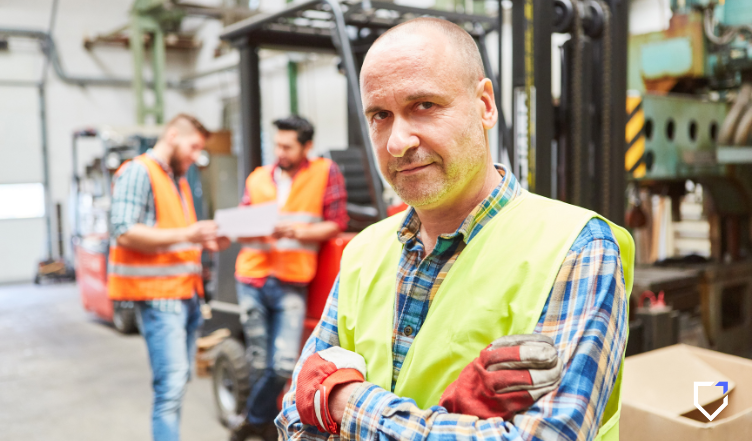As the American workforce continues to evolve, one notable trend is the increasing number of older workers choosing to remain active and engaged in their professions. According to the Bureau of Labor Statistics (BLS), the number of workers aged 65 and older is projected to grow faster than any other age group between now and 2028. With this demographic shift, it becomes crucial for employers to pay special attention to workplace safety for the aging workforce.
A Valuable Asset
Older workers bring experience, expertise, and wisdom to the workplace. They often possess valuable skills, institutional knowledge, and strong work ethics. Employers who embrace and support the aging workforce can benefit from their dedication, reduced turnover rates, and a positive impact on workplace culture. However, it’s vital to recognize aging workers may face unique challenges when it comes to workplace safety.
According to the latest data from the BLS, the number of workers aged 65 and older experiencing work-related injuries has been steadily increasing. In 2019, the injury rate for this age group was 10% higher than the overall rate for all workers. This statistic sheds light on the urgent need to address workplace safety concerns specific to older employees.
Top Work-Related Injuries for Employees 65 and Older
Slips, Trips, and Falls – 48%*
Falls are the most common workplace accidents for older employees, accounting for a significant portion of injuries. Factors such as reduced balance, diminished vision, and slower reflexes can contribute to a higher susceptibility.
Overexertion – 24%*
Overexertion and strains are common among aging workers due to changes in physical strength and flexibility. Lifting heavy objects or engaging in repetitive motions can lead to sprains, strains, and other musculoskeletal injuries.
*Bureau of Labor Statistics
Frontline Workers Lead the Trend
While an aging labor force affects businesses across the U.S. economy, the trend is particularly taxing on the industrial sectors due to an older-than-average workforce.
Frontline Workforce Average Ages
Manufacturing → 44.3*
The manufacturing workforce is older, and aging faster, than the overall U.S. labor force with over one quarter of the manufacturing workforce being 55 or older.
Transportation & Warehousing → 42.8*
The median age of truck drivers is well above the national average of all workers.
Skilled Nursing & Residential Care Facilities→ 43.6*
According to the American Association of Colleges of Nursing, as of 2020, approximately 54% of registered nurses in the United States were aged 50 or older.
*Bureau of Labor Statistics
In frontline jobs, employees of all ages typically perform tasks that put them at higher risk of strain and sprain injury, such as lifting heavy loads, performing repetitive motions, and maintaining tiring or awkward positions. Strain and sprain injuries can result over time, and older workers may report more injuries since they’ve had more time for conditions to develop.
To maintain the quality, productive labor force necessary for successful operations, employers need to prioritize workplace safety measures tailored to the needs of older workers.
Keeping the Aging Frontline Workforce Safe
Creating a safe work environment is a shared responsibility between employers and employees. Here are some key ways employers can reduce the risk of work-related injuries for older workers.
Reducing Overexertion
- Design workstations for ergonomics and modify job tasks that require awkward postures or excess bending, twisting, or reaching.
- Reduce the strain of prolonged standing, possibly with a sit/stand chair or anti-fatigue mat.
- Ensure adequate rest breaks and encourage stretching exercises.
Preventing Slips and Falls
- Regularly inspect and maintain walkways, floors, and stairs.
- Install handrails and slip-resistant flooring and stairs.
- Improve lighting and color contras.
- Promote awareness of appropriate footwear; consider a slip-resistant shoe program.
- Eliminate elevation changes over 1/4 inch.
Creating a Culture of Safety
- Provide safety training programs tailored to the needs of older workers, such as lifting techniques, proper body mechanics, and safe driving practices.
- Offer flexible work arrangements, such as modified schedules or rotating job tasks, to accommodate the changing needs and capabilities of older employees.
Wearable Safety Tech: Empowering Workers of All Ages
Wearable safety technology transcends age and serves as a powerful tool to enhance workplace safety and productivity for all employees. However, it can be particularly beneficial for the aging workforce, contributing to improved ergonomics, increased safety, and enhanced productivity.
Whether it’s lifting heavy objects, bending, or reaching, wearables offer continuous coaching and real-time feedback to workers of all ages, helping them maintain proper techniques and minimize the risk of injuries.
Additionally, a wearable safety solution provides employers with actionable insights into specific ergonomic risks present in the workplace. By utilizing data collected from wearables, employers can identify areas for improvement and take proactive measures to mitigate potential hazards.
Benefits by the Numbers
Wearables can reduce the frequency of workplace injuries by 55%.*
The devices act as a proactive measure, preventing ergonomic injuries and promoting a safer working environment. This leads to reduced claims costs and workers’ compensation premiums.
Wearables have been found to decrease lost work days by up to 72%.*
The devices reduce the rate of worker absences resulting from injuries, leading to cost savings for employers.
Conclusion
By addressing the unique challenges faced by older workers and implementing proactive solutions, employers can create a safer work environment that promotes the longevity, productivity, and overall satisfaction of their aging workforce. It can also pay off in an organization’s bottom line. Leveraging wearables, along with ergonomic practices and a culture of safety, empowers workers of all ages to thrive while ensuring a safer future for the entire workforce.
The Kinetic wearable safety platform is proven to reduce workplace injuries by 55% and lost work days by 72%. Provided to Kinetic policyholders at no extra cost, the Kinetic Reflex detects high-risk behaviors and provides data-driven insights to help protect workers and enhance the bottom line.
Learn more about smarter insurance coverage that keeps workers safe and reduces costs today!
